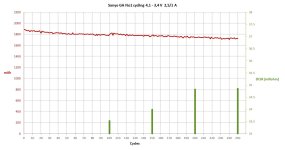Pajda
10 kW
My unwanted remarks to calendar aging:
1) If there are few people who professionally measure the cycle life, there is almost no people who measuring calendar aging and give his results for free. I am also not measuring this particular parameter, at least for now.
2) My personal opinion is that almost all information about calendar aging available on internet are belonging to my favourite category "old wives' advice". It is no offence to other experts, but I think that most of the available results are either outdated or measured at overal shitty cells (like the cycle life tests results) and so did not reflect parameters of newer generations of cells.
3) I am expecting huge difference in this parameter, even for cells from the same category, like you can see in docware cycle life tests, so generalization won't work here either.
1) If there are few people who professionally measure the cycle life, there is almost no people who measuring calendar aging and give his results for free. I am also not measuring this particular parameter, at least for now.
2) My personal opinion is that almost all information about calendar aging available on internet are belonging to my favourite category "old wives' advice". It is no offence to other experts, but I think that most of the available results are either outdated or measured at overal shitty cells (like the cycle life tests results) and so did not reflect parameters of newer generations of cells.
3) I am expecting huge difference in this parameter, even for cells from the same category, like you can see in docware cycle life tests, so generalization won't work here either.




